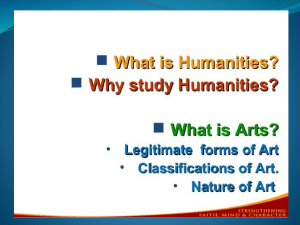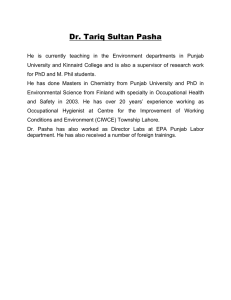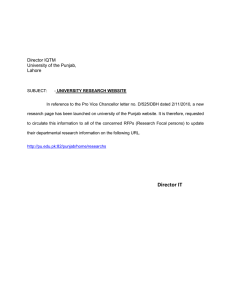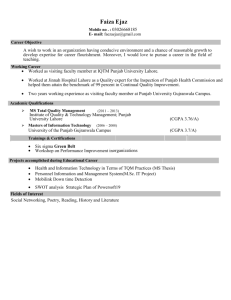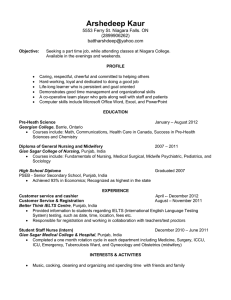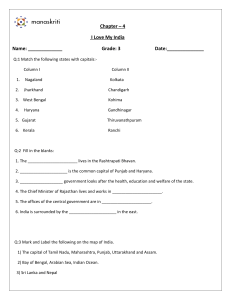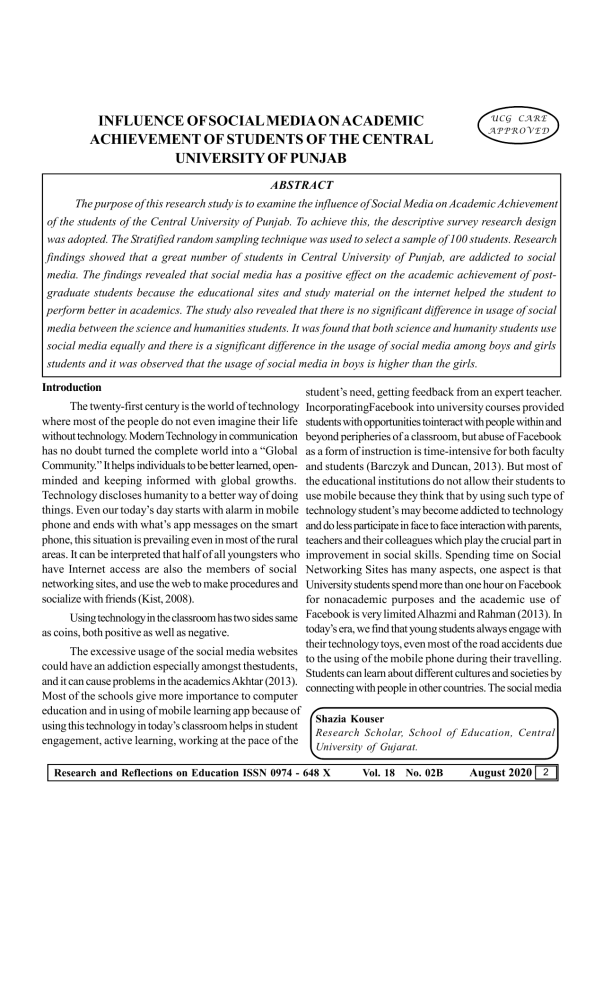
INFLUENCE OF SOCIAL MEDIA ON ACADEMIC ACHIEVEMENT OF STUDENTS OF THE CENTRAL UNIVERSITY OF PUNJAB UC G C AR E APPROVED ABSTRACT The purpose of this research study is to examine the influence of Social Media on Academic Achievement of the students of the Central University of Punjab. To achieve this, the descriptive survey research design was adopted. The Stratified random sampling technique was used to select a sample of 100 students. Research findings showed that a great number of students in Central University of Punjab, are addicted to social media. The findings revealed that social media has a positive effect on the academic achievement of postgraduate students because the educational sites and study material on the internet helped the student to perform better in academics. The study also revealed that there is no significant difference in usage of social media between the science and humanities students. It was found that both science and humanity students use social media equally and there is a significant difference in the usage of social media among boys and girls students and it was observed that the usage of social media in boys is higher than the girls. Introduction The twenty-first century is the world of technology where most of the people do not even imagine their life without technology. Modern Technology in communication has no doubt turned the complete world into a “Global Community.” It helps individuals to be better learned, openminded and keeping informed with global growths. Technology discloses humanity to a better way of doing things. Even our today’s day starts with alarm in mobile phone and ends with what’s app messages on the smart phone, this situation is prevailing even in most of the rural areas. It can be interpreted that half of all youngsters who have Internet access are also the members of social networking sites, and use the web to make procedures and socialize with friends (Kist, 2008). Using technology in the classroom has two sides same as coins, both positive as well as negative. The excessive usage of the social media websites could have an addiction especially amongst thestudents, and it can cause problems in the academics Akhtar (2013). Most of the schools give more importance to computer education and in using of mobile learning app because of using this technology in today’s classroom helps in student engagement, active learning, working at the pace of the student’s need, getting feedback from an expert teacher. IncorporatingFacebook into university courses provided students with opportunities tointeract with people within and beyond peripheries of a classroom, but abuse of Facebook as a form of instruction is time-intensive for both faculty and students (Barczyk and Duncan, 2013). But most of the educational institutions do not allow their students to use mobile because they think that by using such type of technology student’s may become addicted to technology and do less participate in face to face interaction with parents, teachers and their colleagues which play the crucial part in improvement in social skills. Spending time on Social Networking Sites has many aspects, one aspect is that University students spend more than one hour on Facebook for nonacademic purposes and the academic use of Facebook is very limited Alhazmi and Rahman (2013). In today’s era, we find that young students always engage with their technology toys, even most of the road accidents due to the using of the mobile phone during their travelling. Students can learn about different cultures and societies by connecting with people in other countries. The social media Shazia Kouser Research Scholar, School of Education, Central University of Gujarat. Research and Reflections on Education ISSN 0974 - 648 X Vol. 18 No. 02B August 2020 2 have made it possible for like-minded individuals to discuss important topics, widen their personal knowledge and discover things they never knew before. The young people are actively involved in public affairs since social media have provided new opportunities for active participation of people (Barker, 2009). Social networking users face severe health risk because they reduce face-to face contact and become addicted in a virtual world of relationships. People spent hours chatting with their friends and browsing profiles on social networking sites. It becomes a compulsive habit to visit own profile several times in a day for checking friends? updates, changing status, and commenting on others photos and videos. With regard to access the time spent on Social Media platforms that can affect the grades of the students, there is no link of how much times a student spends on social media platforms that can affect the grades directly or indirectly (Martin, 2009). The same result was supported by one another study that was carried out by University of New Hampshire in the year 2010. Social networking site that once was thought to be helping people across the world to unite and making new relationship can also damage the relationship and make life miserable (Das and Sahoo, 2011). With regard to linking Social Media with the academic achievement, It has been found that there is no relationship among social media and students? academic performance (Ahmed and Qazi, 2011, Hanqittai and Hsich, 2010, Pasekand Hanqittai, 2009). Social media and networking sites have become the main way to communicate, share ideas, play games and find information directly. These sites have become so popular that even the most intelligent students spend their free time without thinking about its negative impact. Social media has become gradually popular among students but it is negatively affecting students educationally because they are placing less importance on grades and are missing out on critical knowledge and skills needed for higher education or future jobs and carriers. According to Roberts andFoehr (2008), time spent by students on social networking sites is the same time that they usually uses for extracurricular activities and consequently they are not able to devote time for extracurricular activities. Although Social networking sites are very helpful tool in students? hands, it was found by several studies that a negative impact of social network sites usage on academic performance could arise UC G C AR E the results pointed to negative impact A P P R O V E D of online social media usage on academic performance; hence, as time spent on social networking sites increases, the academic performance of the students is seen to decline. Significance of the study Social media play a crucial and important role in every student’s life. It is easier and convenient to access information and to provide information and communicate via social media.Online tools such as social media provides new opportunities for citizens and stakeholder groups to be informed, identify common interests, express and share opinions and demands, organize, and coordinate interventions. Teaching learning practices are evolving day by day in higher education with emphasis being shifted to student centric learning. Various efforts are being put into practice to use social media to harness effective learning. As younger generations are using such technology in the classrooms, they remark the educational landscape.For learning and teaching, social media is used in a variety of different contexts - language learning, writing development, after-class discussion, synchronous and asynchronous communi¬cation, community building and curricular tool.In the recent years academics have been expanding their social media usage to offer after-hours support for students, deliver and host lectures, dis¬seminate information and engage in discussion. The use of social media has also demonstrated increased teacher-student and stu¬dent-student interaction. With social media, students also become adept at the use of online technologies in learning environments. Use of social media in higher educa¬tion has enhanced learning, increased participation and engage¬ment, improved content dissemina¬tion and improved pedagogy and information sharing.In a related study, Ricoy&Feliz (2016) concluded that twitter promoted a pleasant and motivating climate to students and helped students to improve their reflective, critical judgment and information selection skills. Balakrishnan (2014) assessed the use of Facebook, Twitter, and YouTube in which it is reflected that these sites led to establishment of improved communication among students and lecturers leading to a better teaching and learning environment. While many researchers support the usefulness Research and Reflections on Education ISSN 0974 - 648 X Vol. 18 No. 02B August 2020 3 of social media handles and many among them are those of Punjab was developed by the UC G C AR E who brings forward the negative aspects of these platforms. investigator. APPROVED So it becomes an important aspect to study the effect of Table 1 these websites on the academic achievement of the students. Item wise criteria of the questionnaire on Objectives of the study social media 1. To determine the influence of student addictiveness Total number Criteria to social media. of Questions 2. 3. To explore the differences in the usage of social media among science and humanities students of Central University of Punjab. To determine the differences between the boys and girls students usage of social media network in relation to academic achievement Students addictiveness to social network and academic performance Usage of social media and student’s academic performance Gender usage of social media 10 4 Table 2 Scoring Procedure Hypotheses 1. 10 There is no significant relationship between student’s addictiveness to social media and academic achievement. S. No. Response Scores of Scores of Positive Negative Items Items 1 Strongly Agree 5 1 2 Agree 4 2 3 Undecided 3 3 4 Disagree 2 There is no significant difference between male and female students of Central university of Punjab in the 5 Strongly Disagree 1 usage of social media. Analysis of Data Methodology Table 3 4 2. There is no significant difference between science and humanities stream students of Central university of Punjabin the usage of social media. 3. Research Method Descriptive Survey method has been used for the present study entitled “Influence of social media on Academic Achievement of the students of the Central University of Punjab’’ 5 Coefficient of Correlation between social media and academic achievement of PG students of Central University of Punjab Group N Social media 50 ‘γ’ value Population and sample Ramark at 5% level For the Present study the investigator used the 0.82 Positively correlated Academic stratifiedrandom sampling technique for collection of data. 50 achievement The data was collected from the Central University of Punjab, Bathinda. A total sample size of 100 students were Table 3 shows the coefficient of correlation between randomly selected, as the sample is subdivided into different social media andacademic achievement of post-graduate strata’s i.e. of Science and Humanities and further it can be students of Central University of Punjab. From the table 3 divided into boys and girls. it is clear that coefficient of correlation between addictiveness of social media network and academic achievement has Tools been found to be 0.82 which is strongly and positively Self-made Questionnaire on Influence of Social media correlated. So, it can be interpreted that there is significant on academic achievement of students of Central University Research and Reflections on Education ISSN 0974 - 648 X Vol. 18 No. 02B August 2020 4 positive relationship between social media addictiveness and Findings of the study UC G C AR E academic achievement of post-graduate students. The major findings of the study are: A P P R O V E D Therefore, the null hypothesis1 is rejected at 0.05 level. 1. There was significant positive relationship Table 4 between addictiveness to social media and academic Mean, S.D and ‘t’ value of science and humanities achievement of post-graduate studentsof CUPB. The students’ score of social media scale findings reveal that social media have positive effect on the academic achievement of post-graduate Calculated Remark at Category N Mean S.D ‘t’ value 5% level students because the educational sites and study Science 50 86.3 8.853 material on the internet help thestudent to perform better Non 0.298 in academics significant Humanities 50 85.74 9.899 2. There was no significant difference in usage of social Table 4 shows that the mean score of science stream media between the science and humanities students of respondents was 86.30 and the humanities stream central university of Punjab, Bathinda. It was found respondents was 85.74. The standard deviation of science that both science and humanity Students use social students was 8.853 and the humanities students was 9.899. media equally. The difference between mean was 0.560 and it was in favour 3. There was a significant difference in the usage of social of science students. The calculated ‘t’ value was 0.298 is media among male and female students of central less than the table 1.96 at 0.05level of significance. Hence university of Punjab, Bathinda. From the mean the null hypothesis is accepted which means there is no difference it is evident that the usage of social media significant difference in usage of social media between the among male are higher than the female students. science and humanities stream students of central university Conclusion of Punjab, Bathinda. Social media has now become a very crucial part of Table 5 our personal and professional life. The growth of social Mean, S.D and ‘t’-value of male and female media over the years has transformed how most users students score of social media scale experience the internet. There have been diverse reactions from academics and researchers on the impact of social Calculated Remark at Category N Mean S.D ‘t’ value 5% level networks and how they affect academic performance. Hence, their academic performance must be managed well Boys 50 88.38 10 2.597 Significant keeping in view all the factors that can positively or negatively Girls 50 83.66 8.05 affect their academic achievement. The students who are Table 5 shows that the mean score of male and female using the social media need to be monitored about their respondents. It is clear from the table that the mean value usage of these websites. Despite the fact that the Universities of male respondents is 88.38 and for female respondents is are banning the surfing of these websites in their campuses 83.66. The standard deviation of male students was 10.019 still there is a need to ban the third party software’s which and the female students were 8.050. The difference between help students to access these websites. mean was 4.720 and it is in favor of male students. The References calculated ‘t’ value was 2.597 is greater than the table value 1.96 at 0.05 level of significance. Therefore the null 1. Ahmad, A. (2011). Rising of social network websites in India overview.International Journal of Computer Science and hypothesis is rejected.Hence it is concluded that there is a Network Security, 11(2), 155-158 significant difference between male and female students of central university of Punjab, Bathindain the usage of social 2. Ahmed, I., & Qazi, T. F. (2011). A look out for academic media. impacts of Socialnetworking sites (SNSs): A student based Research and Reflections on Education ISSN 0974 - 648 X Vol. 18 No. 02B August 2020 5 perspective. AfricanJournal of Business Management, 5(12), 3. UC G C AR E Subscription Details 5022. APPROVED Ahn, J. (2011). The effect of social network sites on adolescents' social and academic development: Current theories andcontroversies. Journal of the American Society for informationScience and Technology, 62(8), 1435-1445. 4. Akhter, N. (2013). Relationship between internet addiction and academicperformance among university undergraduates. EducationalResearch and Reviews, To subscribe to our journal “Research and Reflections on Education”, fill in the form given below, draw a DD in favour of “The Manager, Research and Reflections on Education” and send the same to ‘The Manager, RRE. St.Xavier’s College of Education (Autonomous), Palayamkottai-627002, Tamil Nadu’. 8(19), 1793. 5. ANNUAL SUBSCRIPTION FEE Individual / Institution : Rs. 1200/- Akinlosotu, T. N. (2016). Predictors of What Sapp „Consumption amongundergraduate students of Economics in Ambrose All University,Ekpoma. African Research Review, 10(3), 290-301. 6. Alhazmi, A. K., Rahman, A. A., & Zafar, H. (2014, December). Conceptualmodel for the academic use of Social Networking Sites fromstudent engagement perspective. Note: Every author (author/co-author) should pay Rs.1200/- towards the publication of the article/paper that includes annual subscription. In e-Learning, e-Management ande-Services (IC3e), 2014 7. 8. IEEE Conference on (pp. 1-6). IEEE. Category : Individual / Institution Al-Menayes, J. J. (2015). Social Media Use, Engagement Name : ................................................................ and Addictions Predictors of Academic Performance. Designation : .............................................................. International Journal ofPsychological Studies, 7(4), 86. ........................................................................................................... Asur, S., & Huberman, B. A. (2010, August). Predicting the Institution : ................................................................ future withsocial media. In Web Intelligence and Intelligent Address Agent Technology(WI-IAT), 2010 IEEE/WIC/ACM ................................................................................................... International Conference on (1) (492-499). IEEE. 9. Balakrishnan, V. (2014). Using social networks to enhance teaching andlearning experiences in higher learning institutions. Innovations inEducation and Teaching ........................................................................................................ Phone No : .......................................................... E-mail : ................................................................ Banquil, K., Chuna, N. A., Leano, G. A., Rivero, M. A., Bruce, Address to which Journal to be sent : ............................................................. C. A.,Dianalan, S. N., ... &Timog, N. U. (2009). Social ........................................................................................................... International, 51(6), 595-606. 10. : ................................................................ networking sitesaffect one's academic performance ........................................................................................................... adversely. Retrieved August 12,2014. 11. 12. Barczyk, C. C., & Duncan, D. G. (2013). Facebook in higher DD No. : educationcourses: An analysis of students? attitudes, Date : community of practice,and classroom community. Bank : International Business andManagement, 6(1), 1-11. Place : Boyd, D. M. (2008). Taken out of context: American teen sociality in networked publics. University of California, Berkeley. Date : Research and Reflections on Education ISSN 0974 - 648 X Signature Vol. 18 No. 02B August 2020 6
